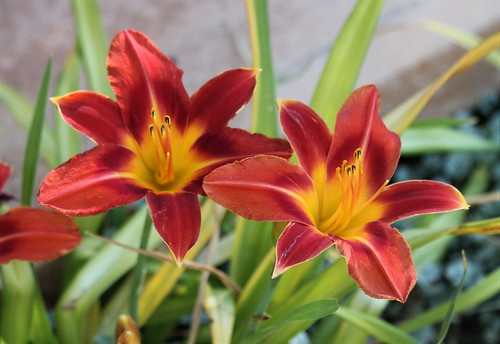Gardening is a great skill for children of all ages to learn, and it’s a great way to bond with the family and spend some time outside. If you’re worried about not having the time or the skill set to maintain a garden, think again. Plants come in all levels of maintenance, so you don’t have to be an expert to have a beautiful, flourishing garden. On top of that, your children become familiar more with healthy eating habits through growing fresh fruits and vegetables.
Below are some ideas of what you can plant to spruce up your garden and provide great visuals to your home, all while teaching your children a new skill.
Gatsby Gal
Oakleaf hydrangeas like Gatsby Gal are very easy to take care of and don’t require a lot of attention. They grow quite large, usually 5 to 8 feet tall. They’re also versatile and can be planted in full sun or part shade. They have beautiful white flower bunches that begin to appear in early summer. In cooler autumn temperatures, the flowers gain a purple-ish tone. Even with their size, they require little-to-no pruning and look great if left alone. You can help your children plant the seeds, and after that, you don’t have to worry about caring for them.
Spilled Wine
Another low-maintenance shrub that adds a huge pop of color to your garden is the Spilled Wine weigela shrubs. Spilled Wine can be planted in sun or partial sun and grow rather low to the ground, reaching no more than 2 to 3 feet in height. Its deep-wine-red foliage stays all season long, and hot magenta flowers begin to appear in early spring, bringing vibrancy to your outdoor space. Best of all, these shrubs require no pruning, which means less time on maintenance and more time enjoying their colors.
Oso Easy Cherry Pie
A third versatile shrub is the Oso Easy Cherry Pie. These landscape roses are much hardier and easier to grow than traditional long-stemmed roses, but they add equal vibrancy and beauty to your home. They grow 2 to 4 feet tall and a little wider than that and require very little pruning. On top of that, they are extremely disease-resistant and bloom for the majority of the summer, making them a truly low-maintenance shrub. In terms of versatility, they love sunlight but are also cold-hardy in even some of the more frigid temperatures.
Daylilies

Image via Flickr by Monkeystyle3000
Beyond shrubbery, there are a number of perennial flowers that can brighten up your yard and don’t require a lot of care. Daylilies aren’t fussy at all and are very versatile. Plant just one to stand out among your other plants or in large groups if you’re looking to cover lots of ground. The only thing they really need is at least six hours of sunlight, so make sure to plant them somewhere they won’t be shaded all day. Morning sun is definitely best, but since they’re rather hardy, they can thrive on their own for the most part.
Bee Balm
Bee balm is another flower, and like its name suggests, it attracts animals like bees, butterflies, and hummingbirds. It has an open, daisy-like shape and has tubular petals that come in a variety of shades like red, purple, white, and pink. As long as the soil around them stays relatively moist, these flowers are fairly easy to care for. It never hurts to add some fertilizer around these perennials, though.
Coral Bells
Coral bells are named after the tall, bell-shaped flowers that bloom in late spring to early summer. They bloom in a variety of colors, such as white and pink to light coral and deep red. Coral bells can be found in several impressive foliage colors, ranging from bronze to purple. If planted in the yard, these flowers need little more than the occasional watering. Consider trimming off spent blooms and cutting overgrowth each spring.
Lettuce
The idea of planting fruits and vegetables might sound intimidating and time-consuming, but luckily that’s not true. There are many veggies you can plant that require very little maintenance, like lettuce. Having fresh lettuce from the garden can also help you shave some dollars off of your grocery bill. Lettuce is a cool-season crop, which means it grows well in the cool, moist weather of spring and fall. Because it’s pretty tolerant of cool temperatures, lettuce can also withstand a light frost if you happened to plant it a little too early.
Radishes
Another great cool-weather crop is radishes, which grow best in lower temperatures and consistently moist soils. Dryer weather can actually make the vegetable tougher and changes the taste of it. Looser soil is also ideal for radishes to allow them to root properly. As long as they have the right temperatures, they are a rather hands-off crop and are great for gardeners of all ages to plant, just like lettuce.
Peas
And last but not least are peas. This crop prefers cooler temperatures and turns out best if you plant them in early spring because hotter months can inhibit their growth. Peas are one of the earliest plants you can start in your garden, too. As soon as your garden has thawed from winter, you can begin sowing your pea seeds. Then after two or so months, you have a host of fresh vegetables to eat, straight out of your own garden. Best of all, your whole family can take pride in knowing they’ve contributed to putting food on the table.
At Crème de la Crème of Lone Tree, Colorado, we focus on hands-on education, and planting a garden with your little ones is a great way to be hands-on at home and boost their learning outside the classroom. These low-maintenance plants listed above are great for beginners, especially your young ones if they want to get involved in seeding and caring for gardens.
